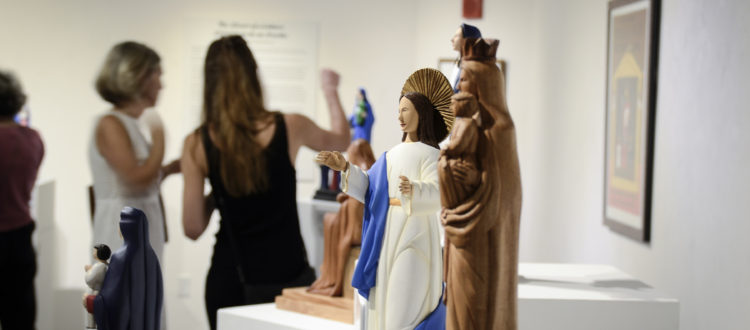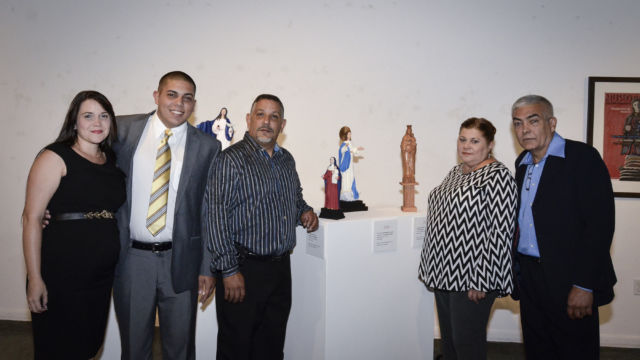THE HEART OF A CULTURE The Santos of Xavier Colón Marrero

Sept. 27, 2014 – Jan. 3, 2015
The centuries-old Hispanic tradition of depicting “Santos” continues with this young master’s depictions of the Virgin Mary.
As a collector of primarily contemporary wood carvings of Santos from my native island of Puerto Rico, it is imperative for me to perceive sincerity in the work before considering adding it to the collection. A clear understanding by the carver of the implications that this work brings forth must be present. The compromise it entails, as well as the application of a personal approach towards carving a piece of wood, define for me the true essence of this popular art. It is deeply rooted in the culture and when properly aligned, reflects the very souls that bring it to reality.
Within the context of Santos, the major force in the history of this art form in Puerto Rico has been the different manifestations of the Virgin Mary. From the beginning of the Colonial influence over 500 years ago, Our Lady of Montserrat, Our Lady of Mount Carmel and the Virgin as a little girl with her mom, known as Santa Ana Triple, are examples of the tradition taking hold. Ultimately, in the 20th century, the Virgin of the Providence is declared Puerto Rico’s official “Mother”, and subsequently, adopted in the repertoire of carvings in the island.
Since 1998, I’ve had the great privilege of meeting some of the master santeros and santeras; don Efrain Torres Camacho, don Lazaro Otero, don Domingo Orta, Sr., don Pedro Pablo Rinaldi Jovet, Antonio Avilés, doña Lydia Acevedo, don Carmelo Soto, Gloria Lopez Estrella, Iris Torres and Jose Luis Peña Burgos, to name a few. These are individuals who have endured the test of time and collaboratively assisted in making sure this amazing tradition continues as strong as ever, defying the constant changes modern times forces on the popular culture.
In order for this tradition to continue strong, young carvers must be cultivated and supported. The seriousness and dedication this line of work requires from the maker of Santos is not trivial, in fact, quite challenging. To encounter a young individual with this degree of patience, conviction and fortitude is uncommon in this day and age. These qualities listed apply to Xavier Jesus Colón Marrero, winner of “the young artisan of 2014” Fomento Award, Puerto Rico. I had already decided to offer this exhibition to Xavier before he was declared the winner of this prestigious award, hence the happiness we all felt upon the news and the reinforcement of my decision. Talent such as this must be brought to the surface and not be contained in any way.
Xavier has visited me a couple times in Gainesville, spending a week at a time studying the collection and eagerly learning about the tradition, history and all the santeros that came before him. He demonstrated a hunger for real knowledge, not just having the ability to use a tool against a piece of wood to carve a Santo he could sell. This maturity at such an early age regarding this art form is rare and I considered it my duty to offer him a forum in which to present his talent. This was a true challenge: to carve at least 25 pieces within a year’s time. Not only this, but 25 manifestations of the heart of the culture in Puerto Rico: the Virgin Mary.
My father, Hector Enrique Puig, reminded me frequently: “Yo soy Mariano!” (a devout believer in the Virgin)…. He had much company in this regard. For this, I dedicate this exhibition to him. I also dedicate it to my dear friend, William Parker, who shared with me so many stories about his research on the Quaternity, which included the Virgin Mary as the fourth entity in the Holy Trinity. A theme that has intrigued me for many years, including it in my collection by many santeros and santeras in the island.
In closing, I am honored that Xavier Jesus Colón Marrero accepted this tremendous challenge and certainly feel very proud of him; young artists such as him bring us hope that the tradition will remain steadfast into the 21st century. Ever onward Xavier and may you serve as an example to anyone who takes upon this path.
Héctor Gabriel Puig Figueroa




















